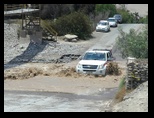
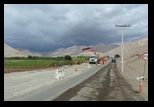
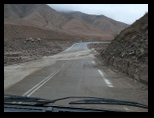
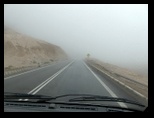
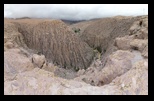


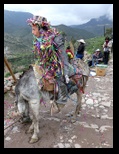



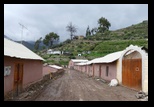

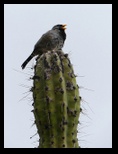
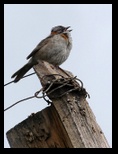
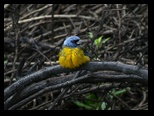

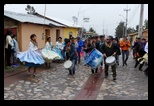
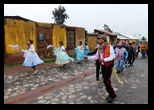
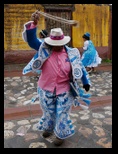
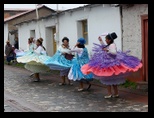
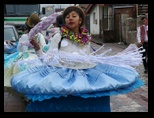
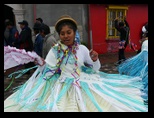
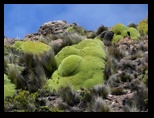

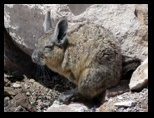
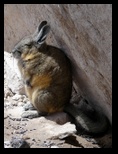
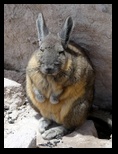
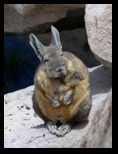

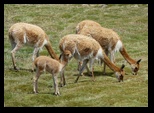
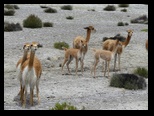
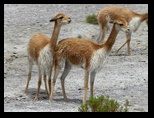

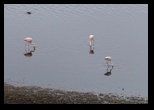
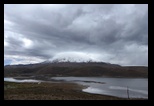
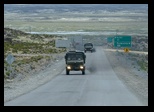
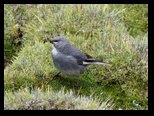
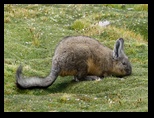
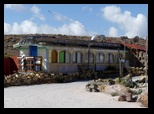
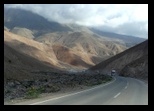
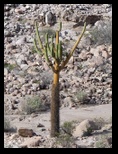
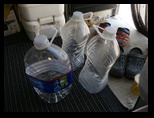


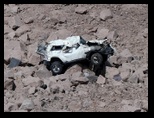

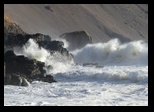
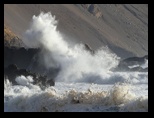
Click on a photo to enlarge it.
We drove from Arica along the Valley of Azapa which is a narrow and very green fertile valley in the desert. There were a number of geoglyphs listed in our Copec books on Chile but we didn't stop for photos. We wanted to get to the village of San Miguel de Azapa where there is a museum whose claim to fame are the oldest mummies in the world. Curiously the museum in Arica boasts the same about their mummies.
We didn't get there because there was a dip in the road going across a river and when we got there the river was gushing across the road. It looked very deep so we pulled over. Another car behind us did the same. We watched as a 4 wheel drive Jeep came from the other side and drove through. Even though the water wasn't that high it still came up to his windows as he drove through! We turned around and so did the other car behind us.
Our plan had been to go up the valley and then cut through onto the Putre road, CH11 which goes all the way to La Paz in Bolivia but the river stopped us so we drove back through Arica, north along Highway 5 towards the border with Peru and then turned onto the CH11 from there.
The highway has heavy traffic because it is tarmac all the way to La Paz and the main route between Chile and Bolivia. There can be up to 500 trucks a day. The first part of the road reflected the heavy traffic and the road was not in very good condition with a number of potholes and rocks strewn across it.
We knew there were roadworks along the stretch - there are probably always roadworks somewhere along the route - and it wasn't long before we hit a traffic queue. There were a great deal of trucks and coaches but we saw that cars were driving past the queue so we did the same. We got closer to the barrier and parked on the left side so that there was enough space for traffic coming from the other direction whenever they were let through. We stopped in the queue at 3-45pm and had a 40 minute wait. The cars were let through at 4-35pm and we drove along a 13km stretch with some gravel but not as bad as the other roadworks near Cuya.
At least the next part of the route was a new road and very nice to drive. It started raining and they obviously hadn't done the road construction very well. There were a lot of water filled dips and they hadn't included drainage. Water gushed across the road leaving rocks strewn across it and, even though the road was quite new, water was already eroding the foundations at the sides and the tarmac was collapsing.
We got up to the Mirador Pucará de Copaquilla (viewpoint) at 3,100m at 5-45pm and parked there for the night. The road continues up and up and seeing as we were coming from sea level we needed to stay low enough for us to be able to sleep. It was only 13° C up here so we had to put warm clothes on. It was still drizzling outside so I went out with our window cleaner that has a sponge on it and gave Winnietwo a clean on the outside using the rain water. He hasn't been washed for a long time and was looking decidedly dirty. It was already getting dark when I went outside so I didn't know whether I'd just made him look worse until the next morning - not a bad job considering that I didn't use any extra water even though I do say so myself!
 Mirador Pucará de Copaquilla - 360° Panorama
Mirador Pucará de Copaquilla - 360° Panorama
(move mouse over panorama and click on the arrows)
Kirsten went to take photos the next morning as we were parked at a chasm where the ruins of the 12th century fortress Pucará de Copaquilla are located. Continuing along the CH11 the road climbed steadily through the pre-cordillera toward the altiplano proper.
We took a detour down a serpentine road to see the Aymara farming village of Socoroma. We were stopped about 850m above the village by a barrier and sign so we parked on the side and Kirsten walked down first to go and take a look whilst I stayed with our vehicle.
She was only gone 40 minutes and came back saying it is extremely muddy down there and it was a good job we hadn't driven the rest of the way. They've had two weeks of rain after a two year drought! Their crops have failed and most people have gone to Arica to get jobs. Now they are getting two years of rain all at once which is causing even more problems. No wonder we couldn't get across the road in Azapa - all the water is coming from up here in the hills.
We drove back up to the main road and headed into Putre. The road was really bad in places with landslides causing a lot of debris and sometimes blocking one side of the road. There were also a lot of huge pot holes. We got to Putre and 3pm and parked up in the main square. It started raining again but we managed to get a fast enough internet connection that we could watch the second half of the German cup quarter finals match where our home team from Hamburg was playing. We lost! So we're out of the cup and still struggling near the bottom of the league and are threatened with relegation (again!)
Putre is at 3,600m above sea level, has a population of 1366 and was originally a 16th-century Spanish settlement to facilitate control of the native population. In the surrounding hills local farmers raise alfalfa for llamas, sheep and cattle on extensive stone-faced agricultural terraces.
It's the start of carnival week in South America and in this tiny village a group of people were singing and dancing accompanied by a loud banging drum and pan flutes. It was interesting in the beginning but they only know one song and kept playing it over and over again ... for over 5 hours!!!!
It had gone down to 9°C inside so we made the bed to get in and keep warm. We didn't have much hope of sleep whilst the same song was being pounded out nearby. We took a video of us with the music in the background. We killed ourselves laughing when we watched the replay because Kirsten was talking about the music and said "Lets listen" and made a face that looked just like Donald Trump! We laughed so hard we cried!
At around 10-20pm the band moved away still singing and dancing through the streets and they didn't come back so we managed to get some sleep.
Driving on CH 11 up to Putre
We checked the internet again the following morning as we don't get a connection very often so we used it whilst we had it. We left at noon and continued up along the windy road and stopped at a Gendarme post. There is a natural water source here so there were a lot of vicuñas and we even saw vizcachas (chinchillas).
Back in Inca times, vast herds of vicuña, numbering in the millions, roamed the altiplano from here all the way to southern Ecuador. But over predation and habitat loss have sorely depleted the herds over the years, and in the 1970s barely a thousand vicuña were left in northern Chile. Today, there are more than 25,000 in the region and several hundred thousand throughout the Andes.
Unlike the alpaca or llama, the vicuña has never been domesticated. These shy fellows just don't seem to want to mate in captivity. So conservationists had to figure out a way to protect them, while still providing an economically viable trade for local Aymara who for centuries have relied on vicuña for their valuable meat and fur. Initially, species-protection measures were put in place, but even its endangered status could not save the vicuña, whose buttery wool is used to make shawls that cost hundreds (if not thousands) of US dollars. In the 1990s the local Aymara started to catch the vicuña live, shear them on the spot, and then release them back in the wild. This innovative program has allowed for continued cultivation of vicuña wool, while providing a deterrent to poachers: a shorn vicuña is essentially worthless. These measures, combined with larger national parks and greater protection, mean that herds of these beautiful, elegant creatures may again trundle across the vast expanses of the high Andes.
We stayed above 4,000m for about 4 hours and carried on up past various lagunas and spotted more vicuñas and even spitting llamas! The road was still pot holed and various short stretches were gravel. We had entered Parque Nacional Lauca with breathtaking scenery and snow sprinkled volcanoes.
The parks most spectacular feature is the glistening Lago Chungará, one of the world's highest lakes and particularly abundant with bird life. Looming over it is the impossibly perfect cone of Volcán Parinacota, a dormant volcano with a twin brother, Volcán Pomerape, just across the border. Our aim was to get up to this lake and then turn around - we weren't going to cross the border here.
Unfortunately there was a large stretch of construction right at the lake. A large queue of trucks told us that they had been waiting a long time. If we tried to get through just to get a better view of the lake it could take us hours to get back.
So we turned around, took a few photos of the lake from where we were and drove back down. We stopped at the same Gendarme post to do the small walk and see more of the wildlife. It was very cold and windy though so we left just before 4pm and continued downhill. We stopped for photos of the candelabra cacti and then pulled up near a borox mine in a parking area off the road for the night. There was a Dixie toilet here so we could empty our toilet - very handy!
We parked up at 6pm and were only about 8km away from the roadworks which we would get to tomorrow. We took photos of our deformed water bottles - the altitude causes a difference in the pressure and we have to keep opening them whenever we go up high or come back down.
The next morning we had breakfast and noticed that there had been no traffic on the road. Yesterday it had been very busy. We knew something was not right and didn't find out until we had driven the 8km to get to the start of the roadworks. The road was closed for construction and they wouldn't be opening it up until 2-30pm for our side and 3-30pm for the other side coming from Arica.
That meant we had to wait almost 3 hours! No wonder there had been no traffic on the road. Fortunately the lady at the barrier told us that there was another route for small vehicles and that we could drive that road aswell. We would have to go back past the borox mine where we had parked last night and another 5km further we would see a gravel turn off on the right signposted Cuesta del Aguila.
So we had a choice - 3 hour wait or 32 km on a gravel road. We chose the latter and hoped the road wasn't too bad. Yes it was gravel and there were roadworks on this road also! But after 9km of going steeply uphill on gravel we saw tarmac!!! Yes!! Tarmac, great. It was an extremely narrow road so the huge trucks wouldn't be able to use it and they'd have to wait for the road to open. The coaches would also have to wait which must be a bit of a nightmare for their timetables.
The road took us through Quebrada del Diablo - Devils Gorge - which we had seen on the map but didn't think we could get to. It was certainly very scenic and was better than driving the same route back to Arica on the CH11.
We even got down to San Miguel de Azapa which we hadn't been able to get to because of high water blocking the road. This time we were on the other side of the river and didn't have to cross it. So we managed to drive along the other side of the Valley de Azapa on the way back to Arica.
Lago Chungará and back to Arica
We spent almost three hours in Arica getting shopping, diesel, water and even got a quote for 4 Michelin tyres which was cheaper than the quote in the Zona Franca, supposedly the duty free area, in Iquique! The Zona Franca is not always cheaper.
We drove out of Arica at 4-30pm heading back along Highway 5 and the same way we had already driven. We were heading for San Pedro de Atacama and the Paso Jama where we would be crossing the border back into Argentina.
So we knew this stretch of road and before we hit the roadworks at Cuya again we turned off west and went to Caleta Camarones a very small shrimp village on the coast and parked up on the beach for the night. The small village had numerous shacks and a lot of old cars dotted around. The beach was clean and the surf was extremely loud - huge waves breaking up onto the beach. At least there was another camper there who had parked at the other end of the beach so we felt safe. Later on the sea fog rolled in - very spooky.
Crashing waves in Caleta Camarones & Music on the road